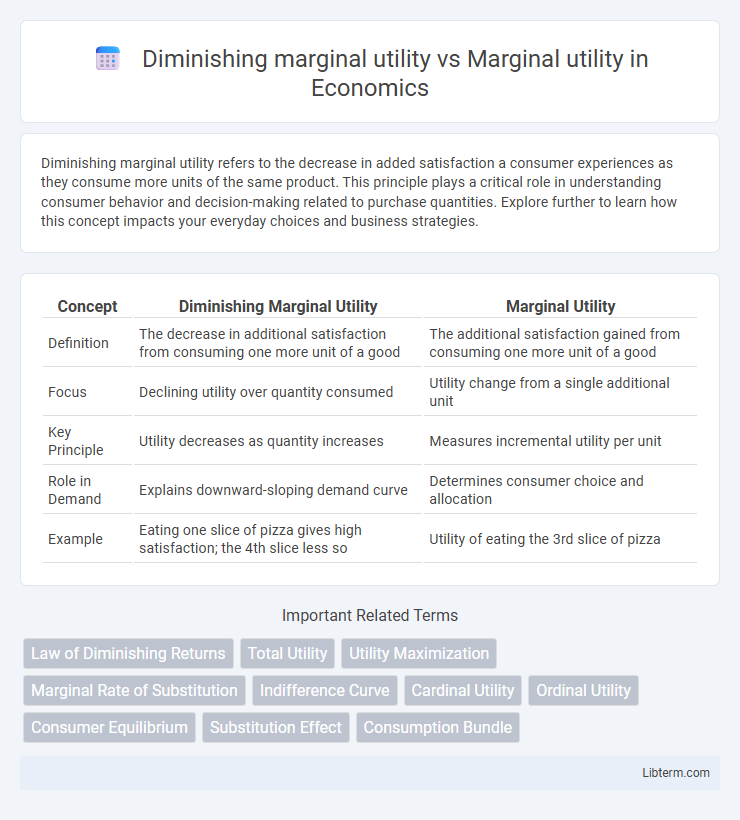Diminishing marginal utility refers to the decrease in added satisfaction a consumer experiences as they consume more units of the same product. This principle plays a critical role in understanding consumer behavior and decision-making related to purchase quantities. Explore further to learn how this concept impacts your everyday choices and business strategies.
Table of Comparison
| Concept | Diminishing Marginal Utility | Marginal Utility |
|---|---|---|
| Definition | The decrease in additional satisfaction from consuming one more unit of a good | The additional satisfaction gained from consuming one more unit of a good |
| Focus | Declining utility over quantity consumed | Utility change from a single additional unit |
| Key Principle | Utility decreases as quantity increases | Measures incremental utility per unit |
| Role in Demand | Explains downward-sloping demand curve | Determines consumer choice and allocation |
| Example | Eating one slice of pizza gives high satisfaction; the 4th slice less so | Utility of eating the 3rd slice of pizza |
Introduction to Marginal Utility
Marginal utility refers to the additional satisfaction or benefit gained from consuming one more unit of a good or service. It quantifies consumer preferences and helps explain demand behavior by measuring changes in overall utility. Understanding marginal utility is essential for analyzing consumer choices and optimizing resource allocation.
Defining Diminishing Marginal Utility
Diminishing marginal utility refers to the decreasing added satisfaction or benefit a consumer gains from consuming each additional unit of a good or service, while marginal utility measures the satisfaction derived from consuming one more unit. As more units are consumed, the marginal utility typically declines, reflecting the principle of diminishing marginal utility. This concept is essential in understanding consumer choice behavior and demand curves in economics.
The Concept of Marginal Utility Explained
Marginal utility refers to the additional satisfaction a consumer gains from consuming one more unit of a good or service, while diminishing marginal utility describes the decreasing value or satisfaction derived from each additional unit consumed. This concept helps explain consumer choice behavior and demand curves, emphasizing that as consumption increases, the incremental benefit typically decreases. Understanding marginal utility is crucial for businesses and economists to optimize pricing, production, and resource allocation based on consumer preferences.
Key Differences: Diminishing Marginal Utility vs Marginal Utility
Marginal utility measures the added satisfaction from consuming one more unit of a good, while diminishing marginal utility describes the decline in additional satisfaction as consumption increases. The key difference lies in the trend; marginal utility can vary, but diminishing marginal utility specifically highlights the decrease in utility with each additional unit. This concept is fundamental in consumer behavior and economic decision-making, explaining why demand curves typically slope downward.
Real-World Examples of Marginal Utility
Marginal utility measures the additional satisfaction gained from consuming one more unit of a good, exemplified when a consumer drinks a second glass of water and values it less than the first during thirst. Diminishing marginal utility occurs because each successive unit provides less added pleasure, such as eating slices of pizza where enjoyment declines after the third slice. Real-world contexts like consumer demand, pricing strategies, and product bundling directly rely on understanding these marginal utility patterns to predict purchasing behavior.
Factors Influencing Marginal Utility
Marginal utility measures the additional satisfaction gained from consuming one more unit of a good or service, while diminishing marginal utility refers to the decrease in that additional satisfaction as consumption increases. Factors influencing marginal utility include individual preferences, the availability of substitutes, and the consumer's current level of consumption or saturation. Income levels, the type of good (necessity or luxury), and the time frame also play significant roles in shaping the perceived marginal utility.
The Role of Diminishing Marginal Utility in Consumer Choices
Diminishing marginal utility refers to the decrease in additional satisfaction gained from consuming each extra unit of a good or service, influencing consumer decisions by signaling when to stop purchasing more. Marginal utility measures the added benefit from one more unit, guiding how consumers allocate resources to maximize total utility. This concept explains why consumers diversify their purchases rather than consuming large quantities of one product, optimizing overall satisfaction.
Economic Significance of Marginal Utility Concepts
Marginal utility measures the added satisfaction gained from consuming one more unit of a good or service, providing critical insights into consumer choice and demand behavior. The principle of diminishing marginal utility states that as consumption increases, the additional satisfaction from each new unit decreases, shaping the downward-sloping demand curve. Understanding these concepts enables economists to predict pricing strategies, allocate resources efficiently, and analyze market equilibrium in microeconomic theory.
Implications for Pricing and Demand
Diminishing marginal utility indicates that as consumers acquire more units of a good, the additional satisfaction from each new unit decreases, leading to a lower willingness to pay over time. Marginal utility, the added satisfaction from consuming one more unit, directly influences demand curves by determining consumer price sensitivity at different quantities. Understanding these concepts allows businesses to set prices that capture maximum consumer surplus while adjusting output to match declining marginal utility, optimizing revenue and market equilibrium.
Conclusion: Understanding Utility in Economics
Marginal utility measures the additional satisfaction gained from consuming one more unit of a good or service, while diminishing marginal utility describes the decline in added satisfaction with each successive unit. Recognizing diminishing marginal utility helps explain consumer behavior and decision-making in economics, as it highlights why demand curves typically slope downward. A thorough understanding of these concepts is essential for analyzing consumption choices and optimizing resource allocation in markets.
Diminishing marginal utility Infographic

 libterm.com
libterm.com